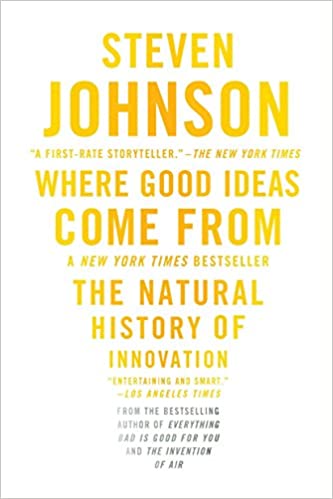
Where Good Ideas Come From: The Natural History of Innovation by Steven Johnson tracks the innovation process through history and shows what ingredients promote a creative climate. From Darwin to the World-Wide-Web we see how individuals, networks, markets, and open-source projects have forged our modern world. Anyone interested in history and/or science should add this to their bookshelf. Every school and professional development library should too.
Introduction: Reef, City, Web
- We start with Darwin discovering that coral reefs can harbor uncountable numbers of species compared to the fewer life forms found in surrounding waters. Then we visit Kleiber’s law which states that the number of heartbeats per lifetime tends to be stable from species to species. Bigger animals just take longer to use up their quota and therefore live longer. When Geoffrey West investigated whether Kleiber’s law and applied it to cities he found that as cities get bigger, creativity per capita increases. Using data like R&D budgets and patents he found that a city ten times larger than its neighbor was seventeen times more innovative and a city fifty times bigger was 130 times more innovative. This is also true for the biological diversity of coral reefs.
- Here we meet the 10/10 rule which states that it takes about ten years for a new innovation to be developed and ten more years for it to be widely accepted. Innovations like color TV, HDTV, AM radio, Video Tape players, CD and DVD players, and GPS navigation all followed that rough time lime. The same was true for the graphical user interface on computers and most software like word processors and spreadsheets. Running counter to the 10/10 rule was Youtube. It went from idea to mass market in two years creating the 1/1 rule. Like YouTube, good ideas want to connect, combine, and cross conceptual borders. They want to complete each other as much as they want to compete.
1. The Adjacent Possible
- The idea for the original baby incubator happened when someone saw how baby chicks were kept warm at a zoo. When modern incubators costing $40,000 were sent to developing counties, however, they soon broke and no one knew how to fix them. An MIT professor named Timothy Prestero got the idea of building incubators using local technology and parts. Since locals in most developing countries could repair cars, he used spare auto parts and his invention was a great success. In many ways, our good ideas are constrained by the parts and skills that surround them.
- The concept of the adjacent possible states that in a given environment there are only so many new things that can be created. In Earth’s early atmosphere, for example, the simple molecules could only create so many more complex molecules, but as they did so further expansion became possible. This fairly describes how evolution works. It also explains why big cities and reefs are more innovative as there are more adjacent possibles. Throughout history, major inventions have happened in multiple places. This is because they couldn’t happen until the parts were available. The trick to having good ideas is to get more parts on the table.
2. Liquid Networks
- A good idea is a network of novel nerve connections and they wouldn’t happen if the nerve connections in our brain weren’t plastic and capable to changing. The new idea also has to be part of the adjacent possible. Since all you have to generate ideas are your genes and your environment, this explains why some environments generate more good ideas than others.
- After explaining why life is based on the connections of the carbon atom and the necessity of water, Steven extends the ideas of why cities produce innovations. A graphic shows the key innovations that occurred prior to the rise of cities and after and there is no contest even though cities haven’t been around that long compared to humans. The Italian Renaissance is an example of how cities and trade promote innovation. The excess wealth they created also promoted the arts.
- The studies of Kevin Dunbar in the early 1990s showed that ideas are more likely to emerge during meetings than in isolation. The results of one person’s reasoning out loud can become the inputs for another person’s reasoning. When people realized this they started designing buildings that would promote more interaction between people. Total open environments don’t seem to work as people don’t like them. The current idea is to have flexible environments where people can get together (conference rooms) and where people run into each other (water coolers). It’s also good to have multiple disciplines in the same building as innovations often happen at disciplinary boundaries.
DrDougGreen.com If you like the summary, buy the book





